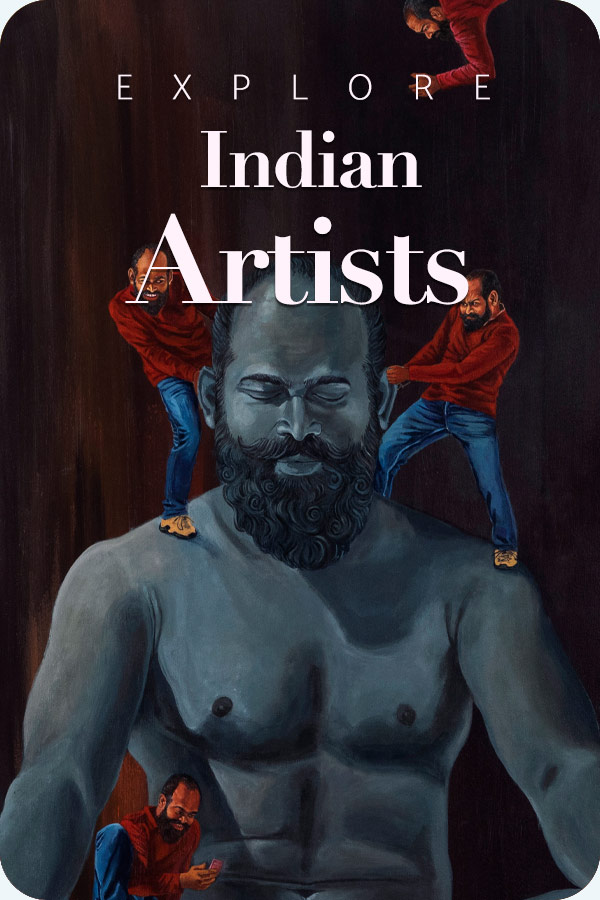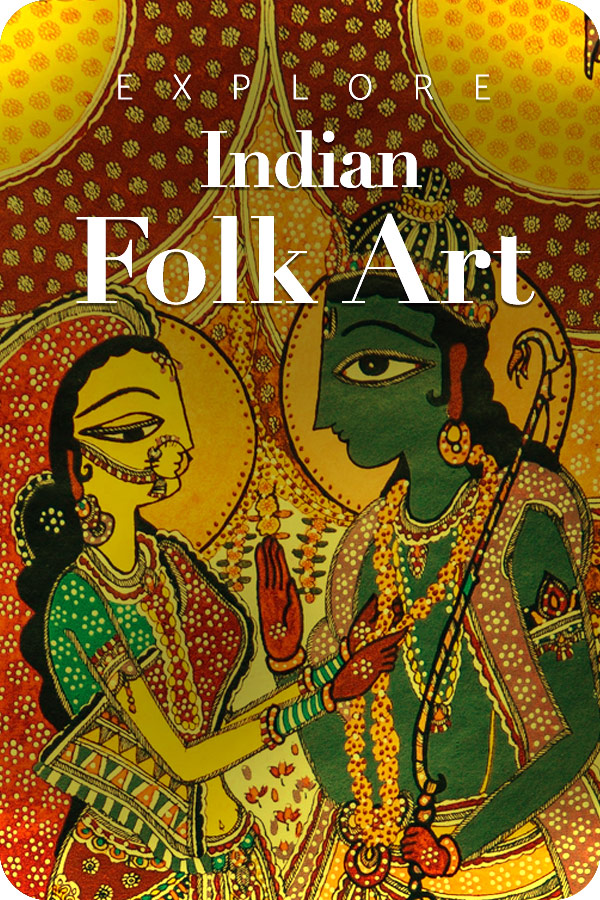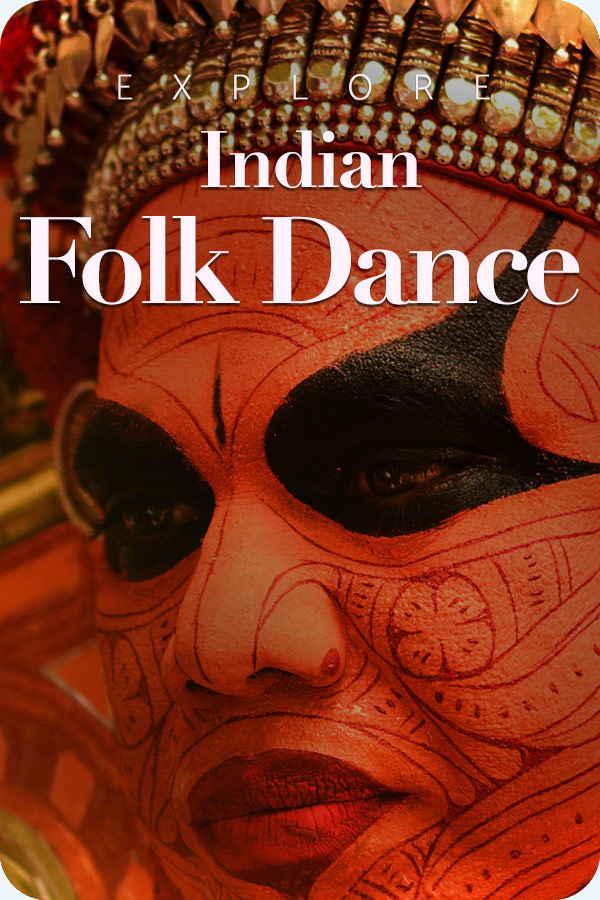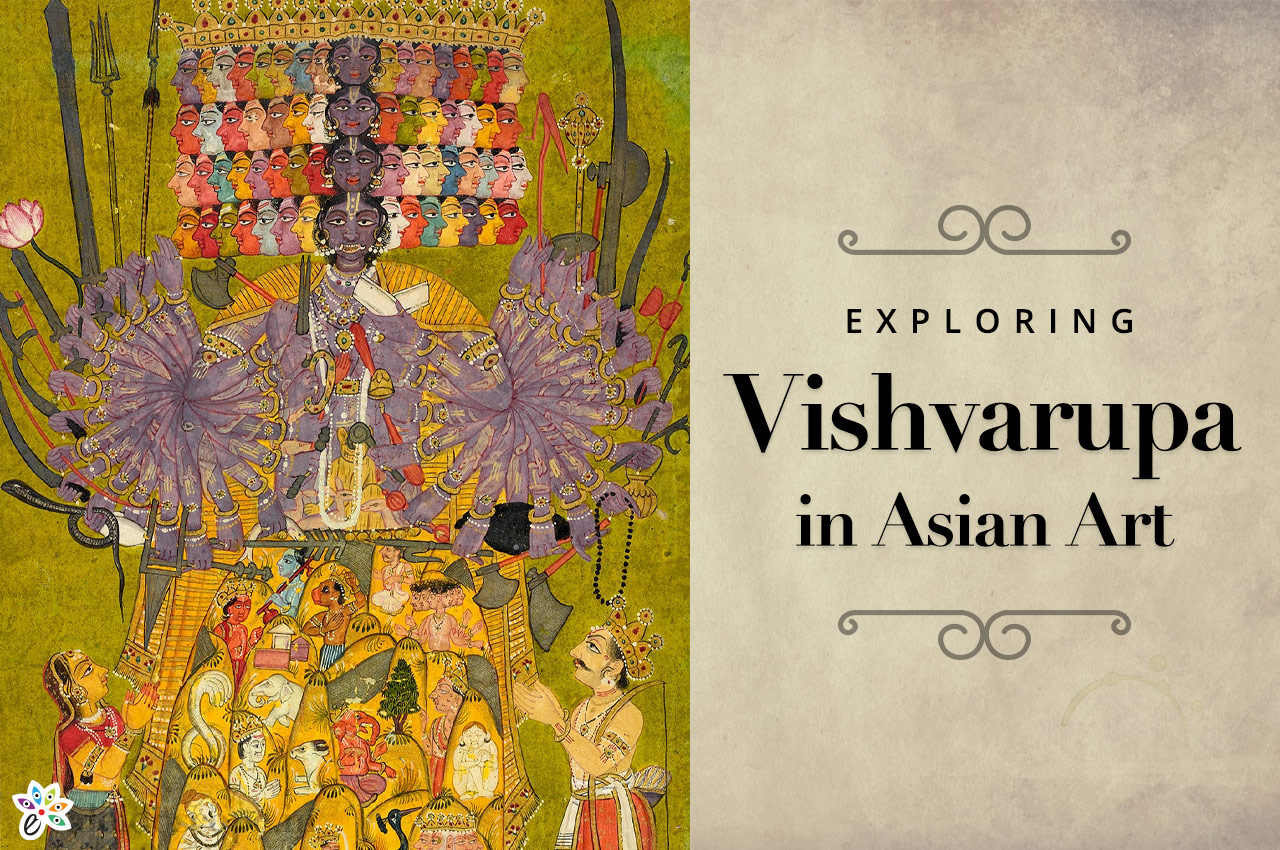
Unveiling Vishvarupa
Did you know that ‘Vishvarupa’, also known as ‘Viratrupa’, is a powerful iconographical and theophanic form of the Hindu deity Lord Vishnu? While there are various depictions of Vishvarupa throughout Hindu texts, the most renowned appears in the Bhagavad Gita, where Lord Krishna reveals this awe-inspiring cosmic form to Arjuna on the battlefield of Kurukshetra, during the great war between the cousins Pandavas and Kauravas.
The word Vishvarupa (from ‘Vishwa’, meaning ‘universe’, and ‘rupa’, meaning ‘form’ translates to “universal form” or “cosmic form”. It represents a manifestation in which the deity encompasses all of existence—every face, every being, every form—symbolizing the totality of the universe contained within the divine.
Vishvarupa signifies the divine as ‘omnipresent’, ‘all-encompassing’, and the ‘source of all creation’. It is a reminder that the divine transcends human limitations and distinctions, embodying the infinite and the eternal.
In art and scripture, Vishvarupa is depicted with ‘countless heads, arms, and legs’, displaying an overwhelming vision of divine glory. Every creature, god, and cosmic element is portrayed as a part of this vast form. This form was revealed by Krishna to Arjuna to dissolve his doubts and fears, revealing the ‘true, boundless nature of the divine’—not just as a charioteer or friend, but as the ultimate cosmic force.
Let us now explore how artists across the ages have envisioned this magnificent form, the ‘Vishvarupa’, in sculpture, painting, and sacred art.
Vishvarupa in Early Asian Art
Depictions of Vishwarupa are seen as early as the 5th century. We can see the same in sculptures from Mathura and Kashmir as described below. A temple in Nepal also has a rare depiction of Vishvarupa.
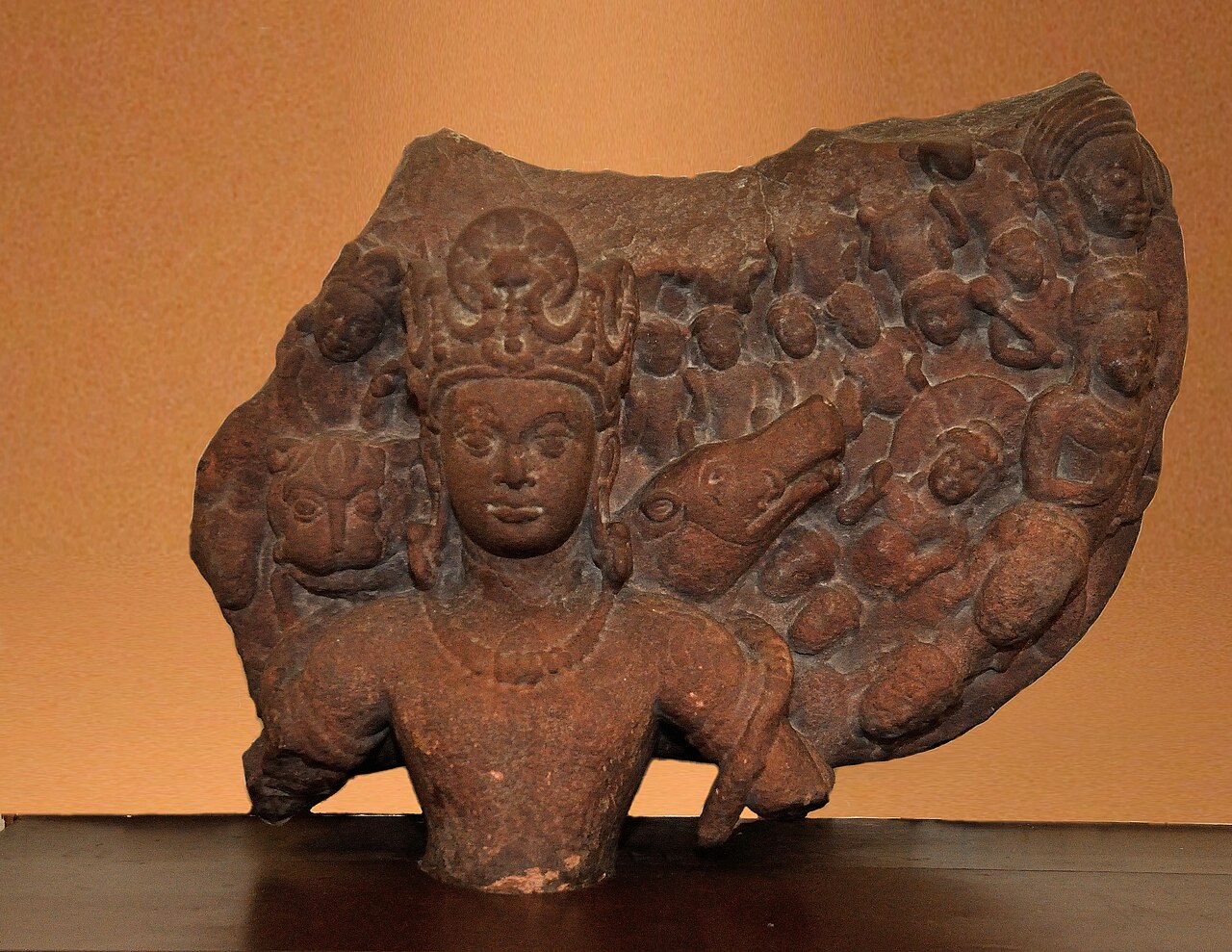
A 5th-century CE depiction of Vishnu from Mathura portrays him as a three-headed cosmic creator. At the centre is Vishnu with a human head, flanked by the heads of two of his avatars, Narasimha, the lion-headed incarnation, and Varaha, the boar-headed form. Surrounding him is a radiant aureole teeming with a multitude of beings, symbolizing the diverse emanations born from his divine creative power.
In the sculpture fragment below of Vishvarupa from 6th century Kashmir, we can see the avatars of Lord Vishnu around his crown with Varaha and Narasimha around his neck.
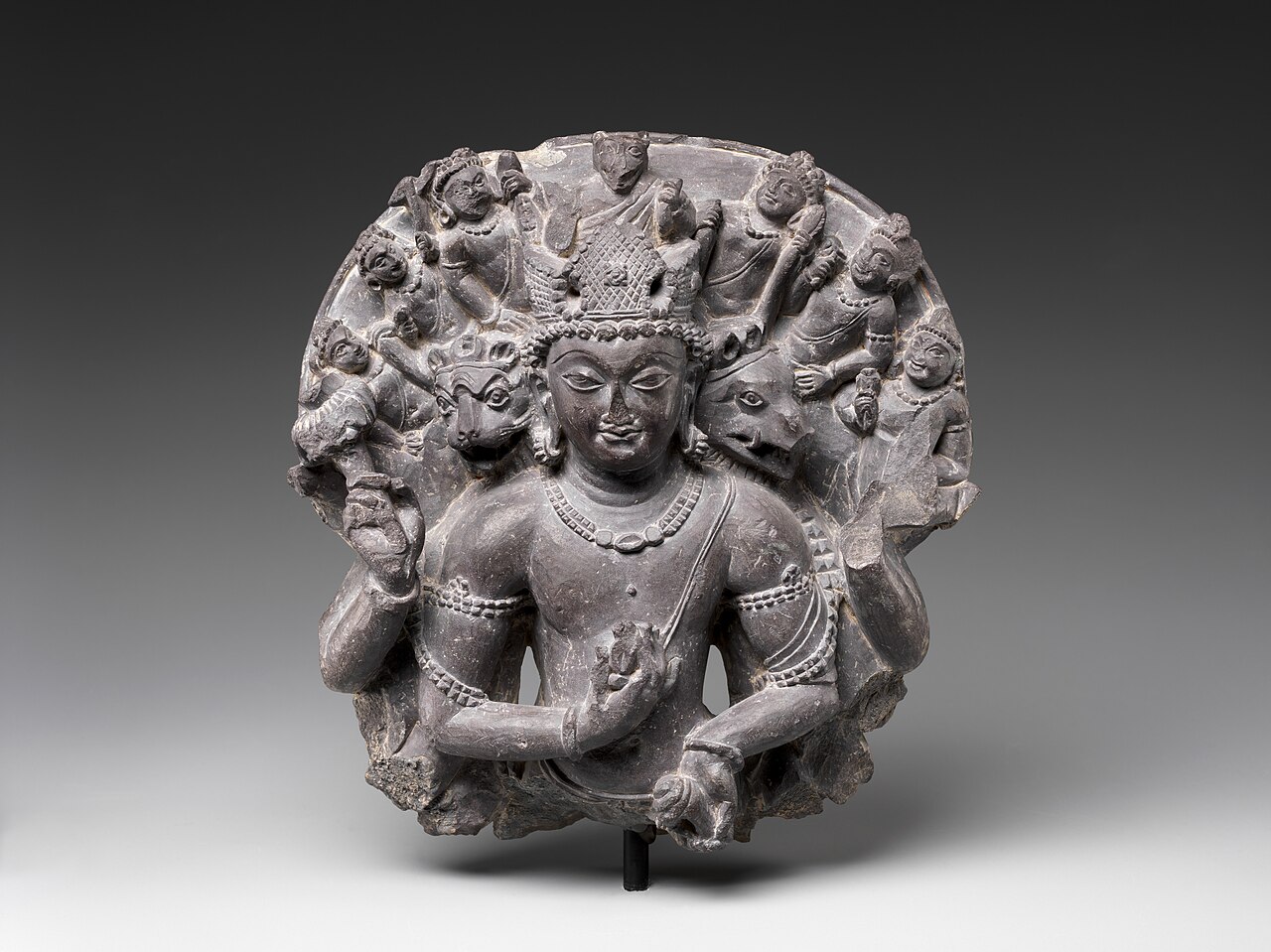
An early and significant depiction of Vishvarupa can be found in the Changu Narayan Temple in Nepal, dating back to the 5th–6th century CE. This stone relief, approximately 70 cm in height, presents a striking image of the deity in his cosmic form. The central figure is depicted with ten heads and ten arms, symbolizing his all-encompassing nature. Surrounding him are representations of the three realms of Hindu cosmology: swarga (heaven), prithvi (earth), patala (underworld). The composition also visually expresses a moral and cosmic dichotomy: Figures to the right of Vishvarupa are demonic, representing chaos and opposition, while those on the left are divine, signifying order and harmony. This contrast illustrates the god’s dual nature, encompassing both light and darkness, creation and destruction, within a single unified cosmic body.
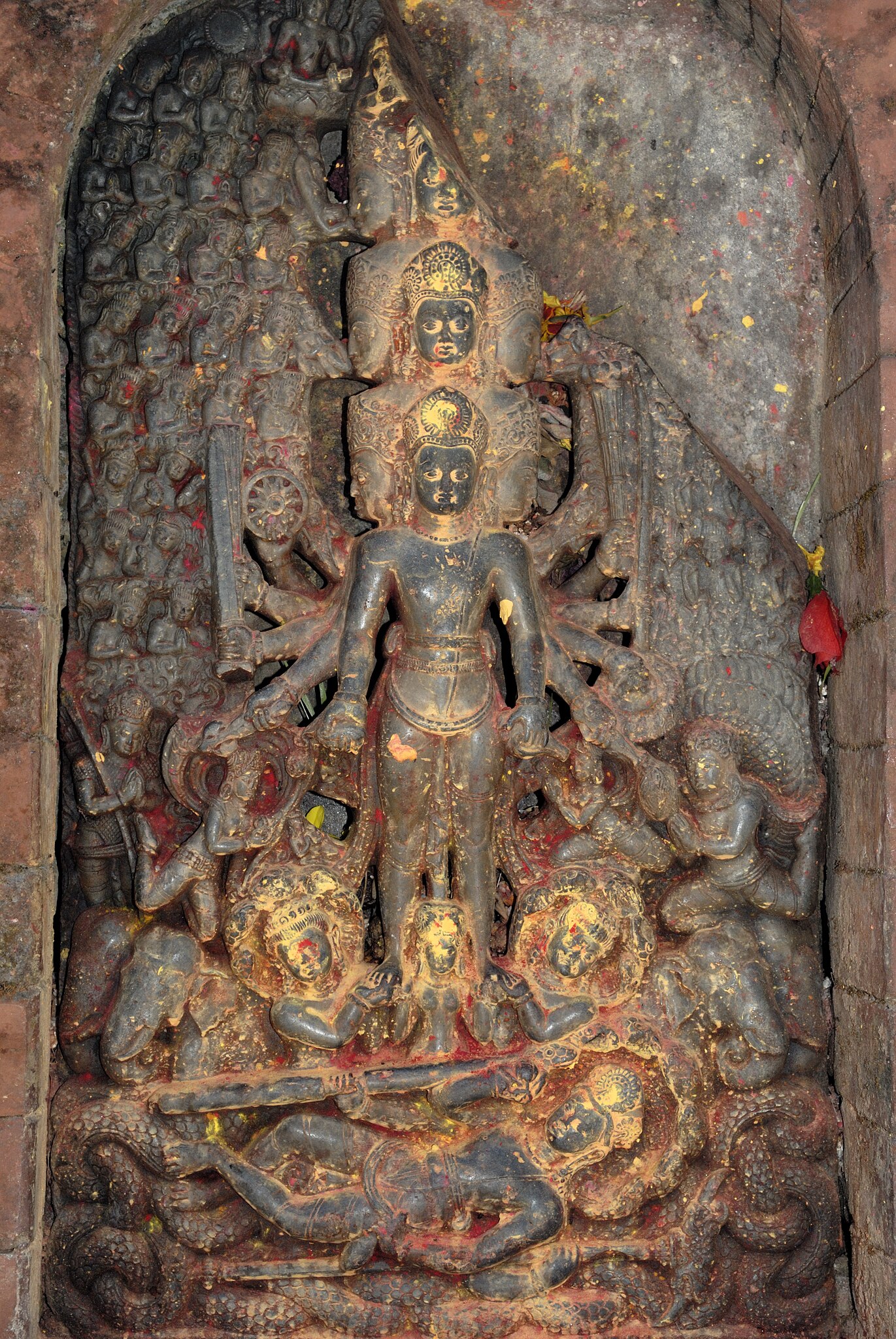
Texts of the Vishvarupa
In the Bhagavad Gita
The most famous account of the Vishvarupa happens in the climactic war in the great Indian epic Mahabharata, where the Pandava prince Arjuna and his brothers fight against their cousins, the Kauravas, with Krishna as Arjuna’s charioteer. Faced with the moral dilemma of whether or not to fight against and kill his own family, Arjuna has a crisis of conscience. To appease him, Krishna discourses with Arjuna about life and death as well as dharma (duty) and yoga in the form of the ‘Bhagavad Gita’. In chapters 10 and 11, Krishna reveals himself as the Supreme Being and finally displays his ‘Vishvarupa’ to Arjuna. Arjuna experiences the vision of the Vishvarupa with divine vision endowed to him by Krishna. Vishvarupa’s appearance is described by Arjuna, as he witnesses has innumerable forms, eyes, faces, mouths and arms. All creatures of the universe are part of him. He is the infinite universe, without a beginning or an end. He contains peaceful as well as wrathful forms. Unable to bear the scale of the sight and gripped with fear, Arjuna requests Krishna to return to his four-armed Vishnu form, which he can bear to see. Fully encouraged by the teachings and darshan of Krishna in his full form, Arjuna continues the Mahabharata War.
In the Mahabharata
There are two more descriptions in the Mahabharata, where Krishna or Vishnu-Narayana offers the theophany similar to the Vishvarupa in the Bhagavad Gita. When negotiations between Pandavas and Kauravas break down with Krishna as the Pandava messenger, Krishna declares that he is more than human and displays his cosmic form to the Kaurava leader Duryodhana and his assembly. Vishvarupa-Krishna appears with many arms and holds many weapons and attributes traditionally associated with Vishnu like the conch, the Sudarshana chakra, the gada (mace), his bow, his sword Nandaka. The inside of his body is described. Various deities (including Vasus, Rudras, Adityas, Dikapalas), sages and tribes (especially those opposing the Kauravas, including the Pandavas) are seen in his body. This form is described as terrible and only people blessed with divine vision could withstand the sight.
The other theophany of Vishnu (Narayana) is revealed to the divine sage Narada. The theophany is called Vishvamurti. The god has a thousand eyes, a hundred heads, a thousand feet, a thousand bellies, a thousand arms and several mouths. He holds weapons as well as attributes of an ascetic like sacrificial fire, a staff, a kamandalu (holy-water pot).
Another theophany in the Mahabharata presents a ‘Vaishnava,’ form; related to Vishnu or Krishna. Unlike the ‘Vishvarupa’, it lacks the multitude of limbs, yet still conveys the deity’s vast and cosmic nature. His head stretches across the sky, his two feet cover the entire earth, his arms extend across all horizontal space, and his belly fills the vast, expanse of the universe.
In the Harivamsa
The ‘Harivamsa’, a supplement to the Mahabharata, also contains significant references to Lord Vishnu’s ‘Vishvarupa’, his universal, all-encompassing form, describing it as the embodiment of all the gods. In one instance, during a great Devasura war between the gods and demons, Vishnu assumes the ‘Vishvarupa’ to combat the asuras. In this terrifying and powerful form, he defeats several prominent demons, including Taraka and Maya, underscoring his supremacy and his role as the protector of cosmic order.
The ‘Vishvarupa’ is also invoked in another episode involving Vishnu’s ‘Vamana’ avatar, the dwarf Brahmin boy. In this narrative, Vamana approaches the asura king Bali during a grand sacrificial ritual and humbly asks for three steps of land as a donation. When Bali agrees, Vamana suddenly expands into his cosmic form, Vishvarupa, revealing his divine identity. The Sun and the Moon become his eyes, the Earth forms his feet, and the heavens his head, his body contains a multitude of divine beings and celestial entities: the Vasus, Maruts, Ashvins, Yakshas, Gandharvas, Apsaras, as well as the Vedic scriptures and sacrificial rituals themselves. With just two strides, Vishnu covers the Earth and the heavens. For the third, he places his foot on Bali’s head. Recognizing Vishnu’s divine nature, Bali submits and accepts Vishnu’s lordship. As a result, he is respectfully banished to the realm of ‘Patala’ (the underworld), where he continues to be honored as a righteous and devoted figure.
This episode emphasizes Vishnu’s ability to contain the universe within himself and to restore dharma (the basic principle of divine law in Hinduism, Buddhism and Jainism) through both humility and divine majesty.
In Miniature Paintings
The form of ‘Vishvarupa’ caught the imagination of miniature painting artists as well. This form of painting which was born in the 7th/8th to 12th centuries under the Pala empire of Bengali and 12th to 16th centuries in Western India mostly made on palm-leaf, also flourished during the 17th to 19th centuries under the central and northern hilly Rajput and Pahadi patrons. The paintings were small in scale but phenomenal in detail and started being made on paper There was a Mughal influence and a hybrid artform along with local sensibility which started making its mark. Made using organic sources for the pigments, miniature painting is an intrinsic and vital part of the art history of India. The Vishvarupa has been depicted in the Rajasthani and Pahari schools. The Pahadi painting shows Arjuna totally awed at the vision of ‘Vishvarupa’ of Lord Vishnu as Krishna. The cosmic form has been depicted with many heads and arms holding emblems.
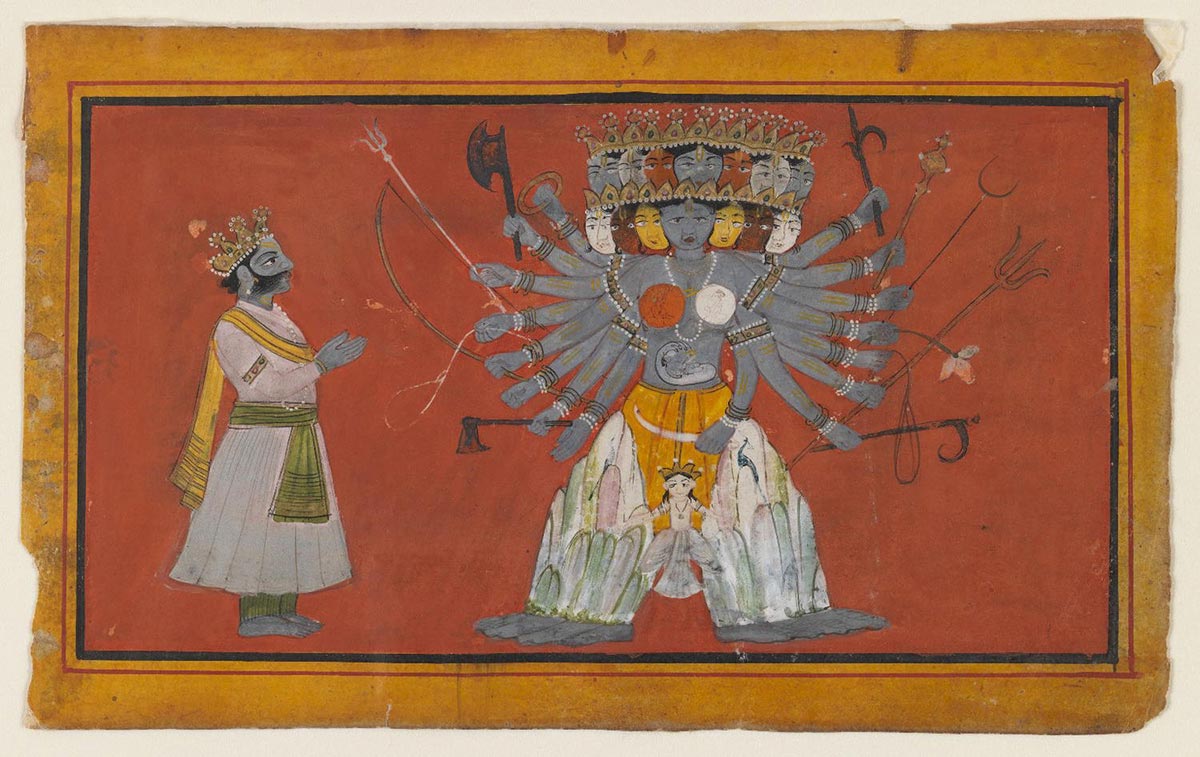
A painting from Rajasthan, probably a ‘pichwai’ (paintings on cloth placed behind the main deity), depicts all the three realms in the ‘Vishvarupa’. Heaven, earth and the underworld are depicted; Lord Vishnu is in his blue complexion with many heads and carrying emblems in his multiple hands. The heaven region shows many celestial beings.
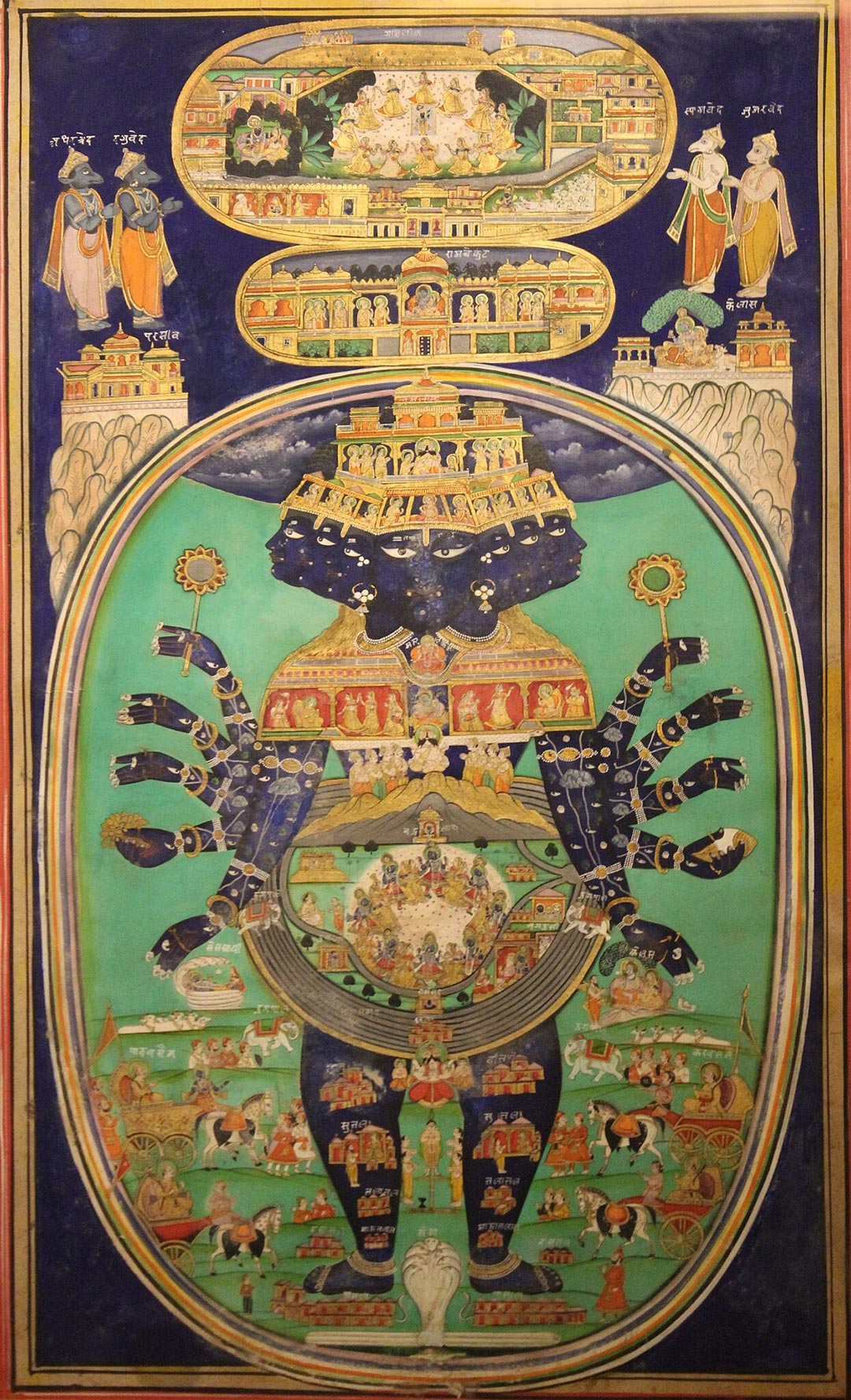
A painting from Jaipur dated to the early 19th century shows the ‘Vishvarupa’ with only one head but depicts the three realms with various beings all over Lord Vishnu’s blue persona. There is a halo like aura around his head with many heads including those of celestial beings which represents the cosmic angle. He holds emblems in his four hands, the chakra (disc), sankha (conch), padma (lotus) and gada (mace). The lower regions depicts reptilian animals sgnifying the underworld or patala. The upper most part is swargam, meaning heaven, the mid-portion represents prithvi or erath where ordinary people live.
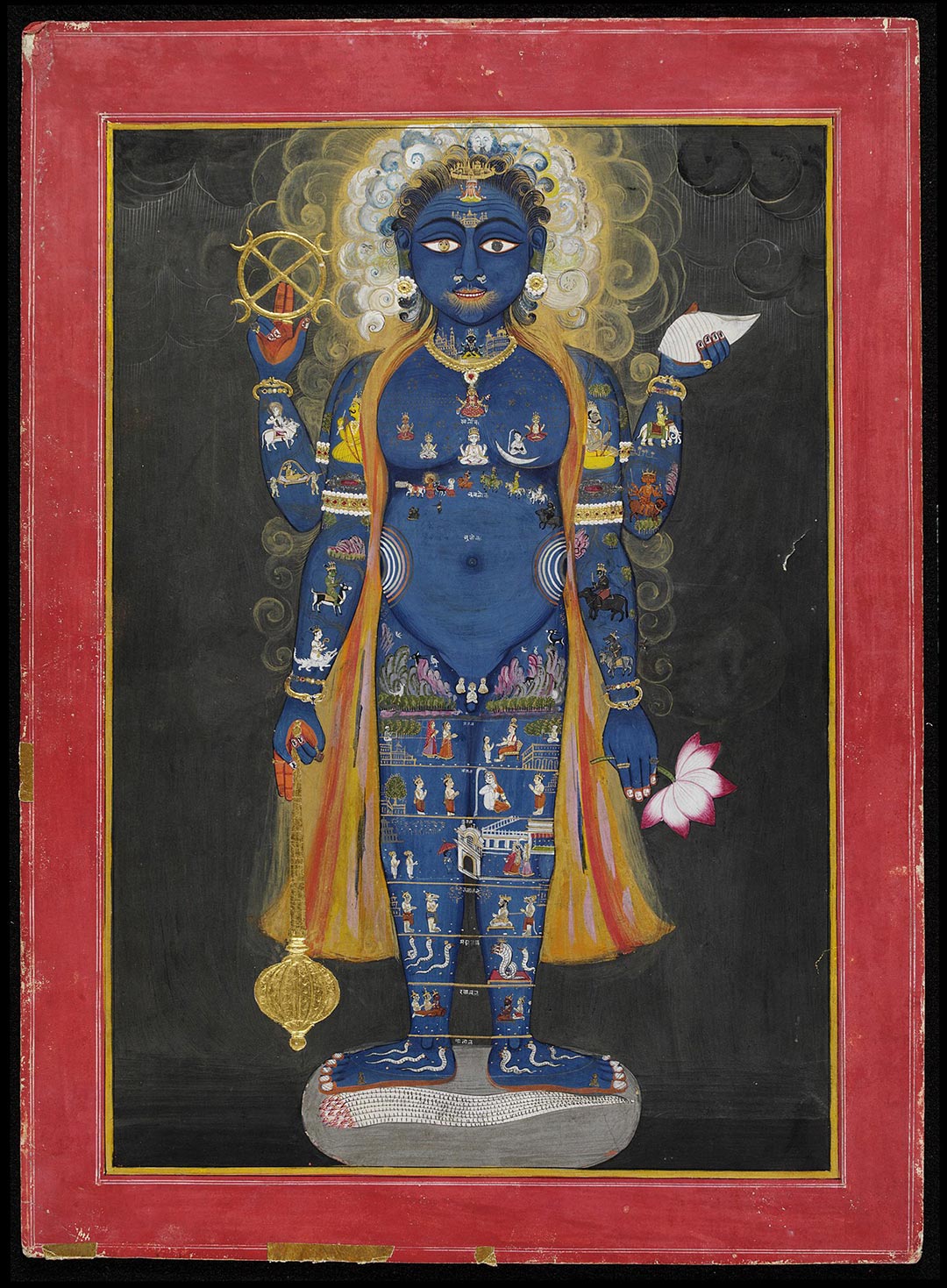
A Pahadi painting from Bilaspur dated to circa 1740 represents the awe-inspiring ‘Vishvarupa’ image with many heads in layers over the main head. It includes many higher beings including gods. In his many hands the cosmic form holds emblems and weapons. He has been shown with multiple legs and two devotees on each side paying their obeisance.
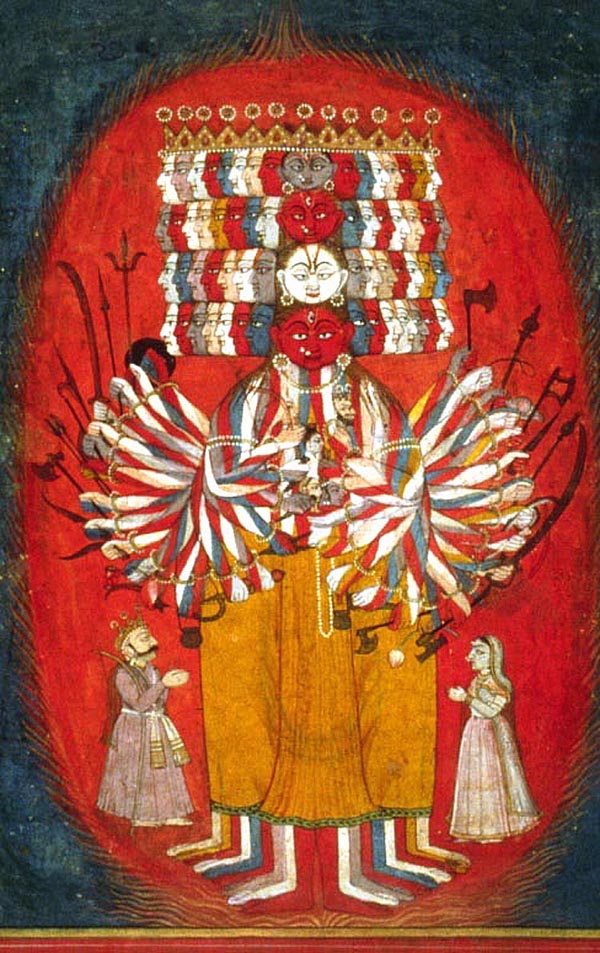
A translated verse from the Bhagavad Gita about the ‘Vishvarupa’ reads –
“Now, behold, O Arjuna, in this My body, the entire universe centered in one, including the moving and the unmoving, and whatever else you desire to see”.
Arjuna said, “O God, I see all the gods in Your body, as well as hosts of various classes of beings, Brahma the Lord seated on the lotus, all the sages, and the celestial serpents.”
A Pahadi painting from Bilaspur dated to circa 1740 represents Vishvarupa image as one with many heads in several layers with many higher beings including gods. In his many hands the cosmic form holds emblems and weapons. He has been shown with multiple legs and two devotees on each side paying their obeisance. The lower part of his boy shows beings of different types including animals.
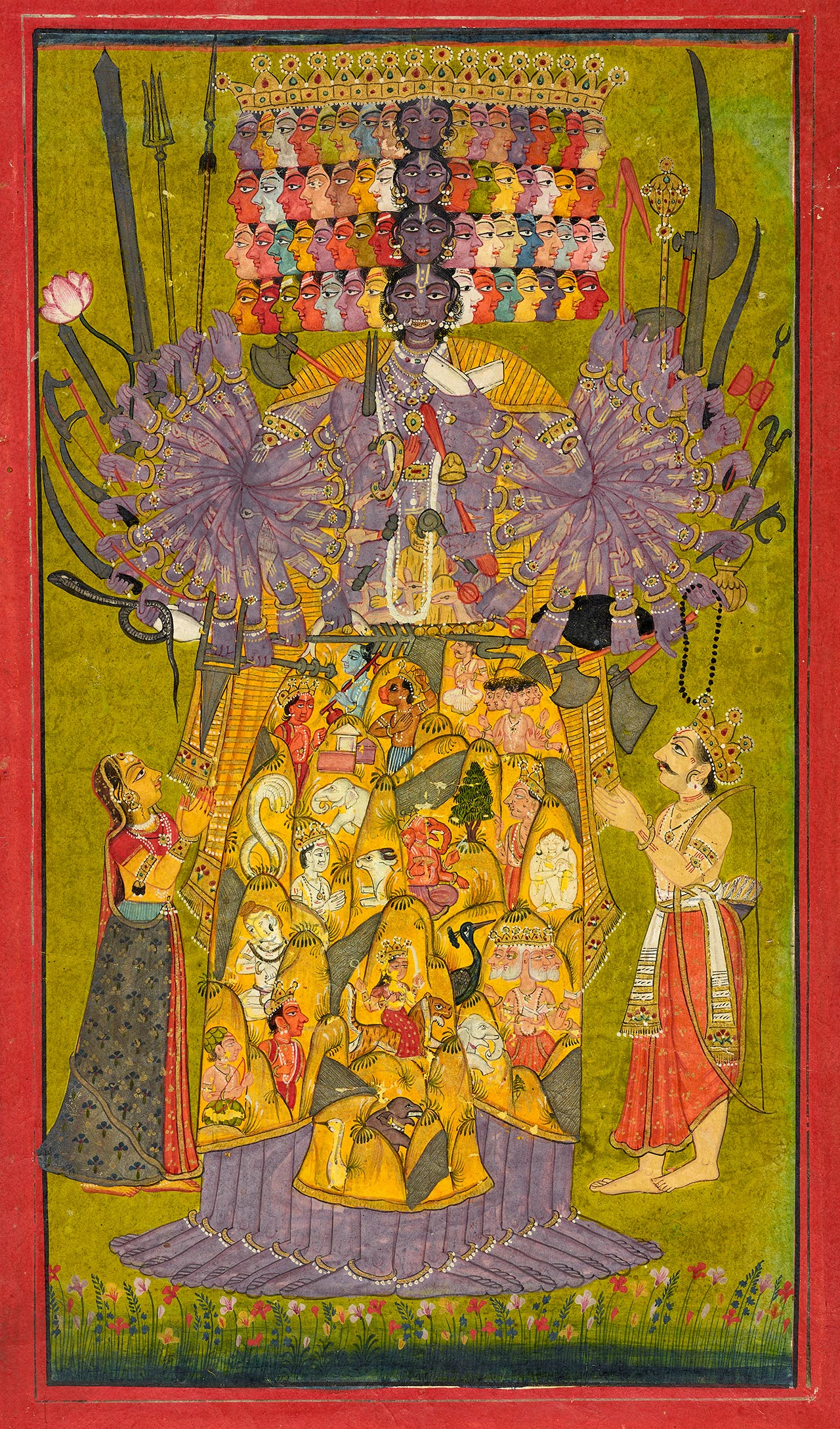
A unique miniature painting from 18th century, Rajasthan shows Arjuna bowing to Vishvarupa’s awesome form where he is shown with a large head and an extension behind with many beings. He has multiple hands and legs.
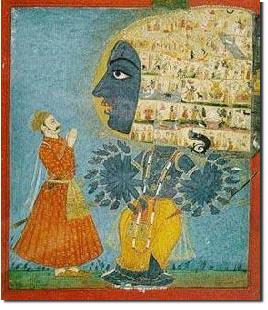
Statues of Vishvarupa
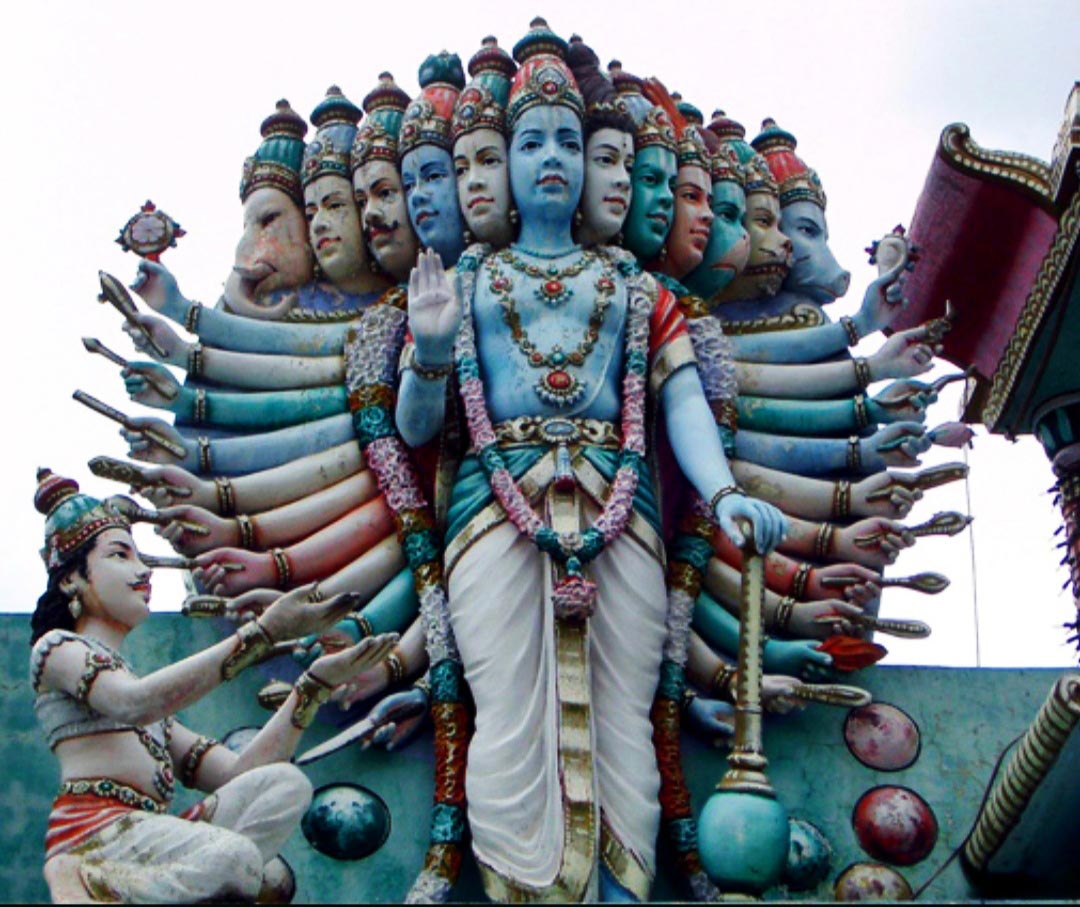
A bronze statuette of Vishnu as ‘Vishvarupa – sandarsana murthy’ shows him with multiple hands. He stands on a pedestal and is having emblems in his hands.
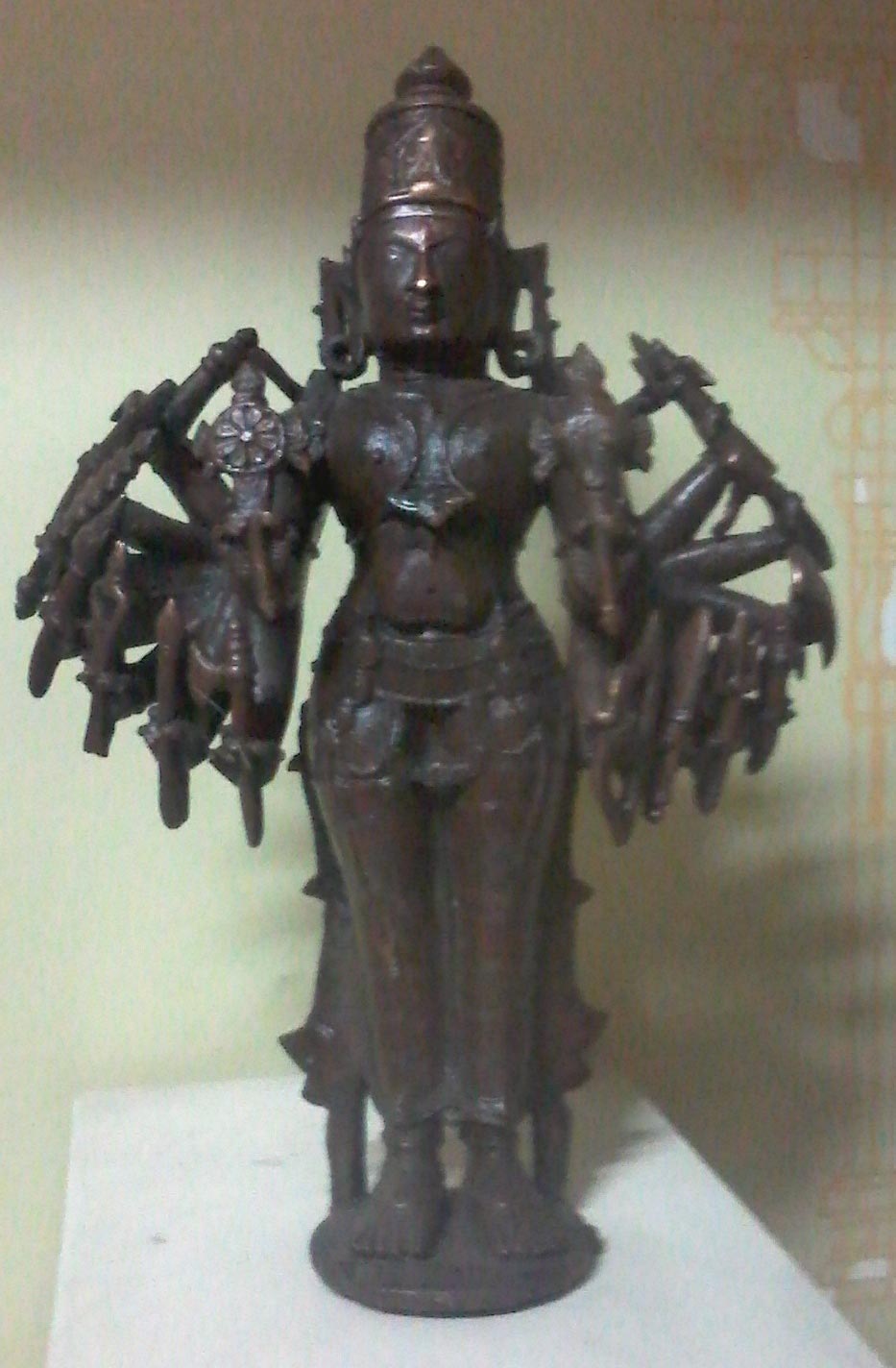
In Modern Times
The images of ‘Vishvarupa’ continues to influence artists in the modern times as well. In the early years of the 20th century lithographic prints were made of Vishvarupa. Also artists have recreated the scene of Arjuna bowing down before the Vishvarupa. In the lithographic print Vishvarupa is shown with many heads and arms holding emblems. Different gods, sages and other beings are shown among his many heads.
The painting of Arjuna bowing to Vishwarupa is set in the battlefield. Arjuna is totally surrendering to Vishvarupa of Lord Krishna (an avatar of Lord Vishnu) who is expressed through his many heads of gods, sages and others reflecting his vastness and spiritual greatness.

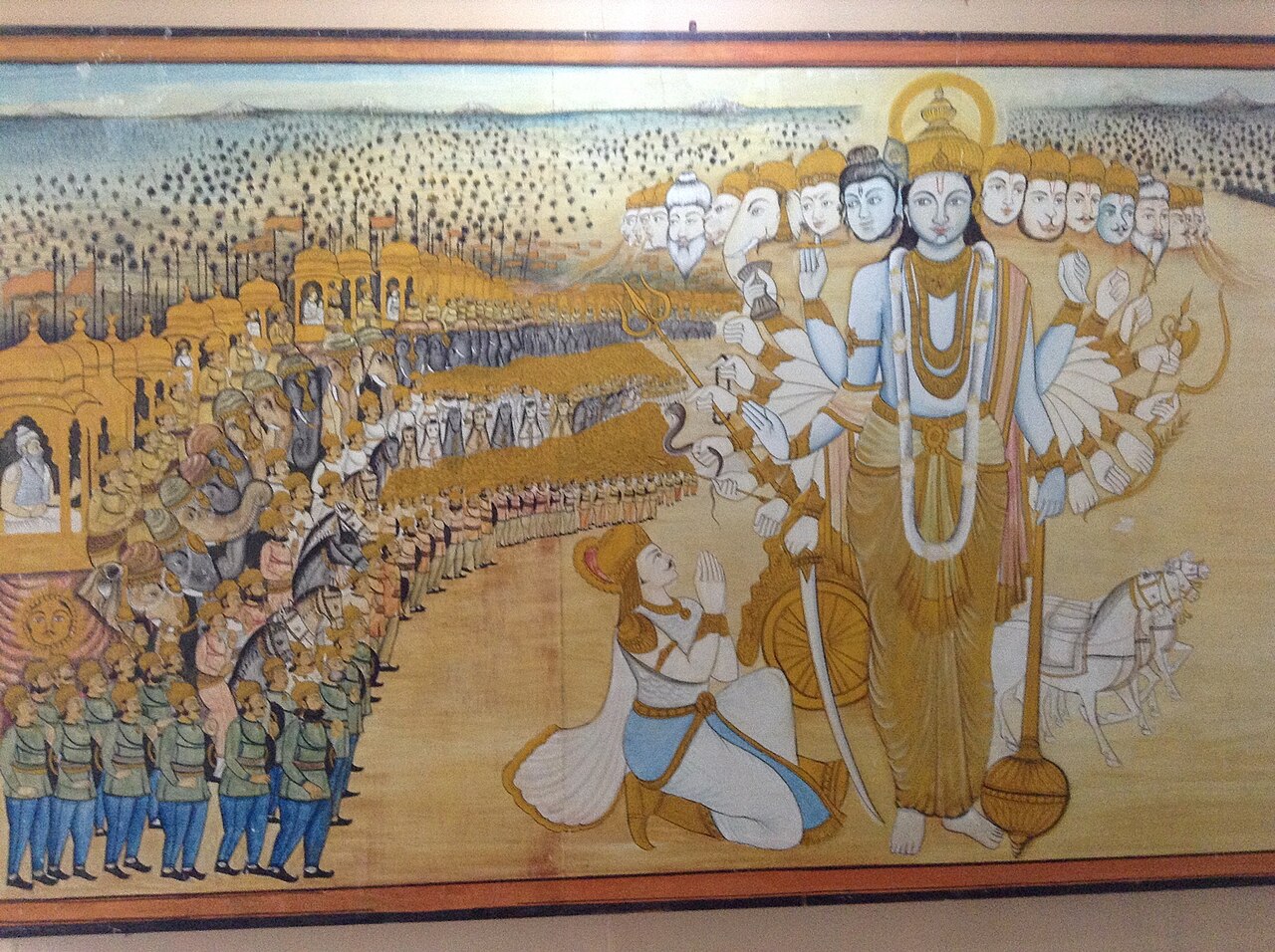
These representations of the cosmic form of Lord Vishnu not only help us in understanding the concept of the universal creator in Hinduism, a part of the Trinity of the Gods, but also gives us an opportunity to reflect on the iconography of ‘Vishvarupa’ and its many depictions in art. Other than the images depicted the ‘Vishvarupa’ has been done on Pichwai, as Madhubani paintings and carved in wood as well, highlighting its universal appeal in art.
References
- https://www.wisdomlib.org/definition/vishvarupa (accessed 20.10.2025)
- https://www.artisera.com/blogs/expressions/miniature-paintings-of-india-chronicling-history-through-the-ages
(accessed 20.10.2025)
- https://www.mynachiketa.com/moral-stories/bhagavad-gita/english/krishna-showed-his-vishwaroop (accessed 20.10.2025)
- https://bhagavadgita.io/chapter/11(accessed 20.10.2025)
- T. S. Maxwell (1988) Visvarupa, London: Oxford University Press.


